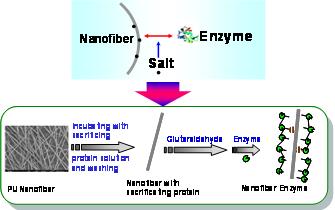Preparation and application of high-performance biocatalysts constitute one of the most important aspects of industrial bio-technology. Electrospun nanofibers have a one-dimensional nanostructure, offering promising characteristic for the preparation of high-performance immobilized biocatalysts. Influences of simple inorganic salt incorporated in nanofibers on protein-materials interactions have been ignored in previous studies. Researchers from Institute of Process Engineering, Chinese Academy of Sciences (IPE-CAS) made in depth studies on the manipulating mechanism of inorganic salts on the performance of immobilized enzymes.
LiCl is a kosmotrope that generally promotes protein salvation in aqueous solutions. IPE Researchers found that LiCl embedded in electrospun polymeric nanofibers interestingly induced an abnormal proteinadsorption and substantially augmented the adsorption capacity of the fibers. They prepared polyurethane nanofibers used for biodiesel synthesis by electrospunning method. Two layers formed in the preparation of the nanofibers. The first layer was bovine serum albumin (BSA) protein which adsorbed onto nanofibers and the outer layer was enzyme crosslinked to the pre-adsorbed protein.
The effect of LiCl content on immobilization of lipase and reusability of nanofibrous lipase for biodiesel synthesis were discussed in the work. The results showed that LiCl induced high activity and substantially improved the reusability of nanofibrous lipase for biodiesel synthesis. Compared with fibers without LiCl, nanofibrous lipase with 5wt% LiCl showed much higher reaction rate and could be reused for 42 cycles without LiCl loss.
The results of this research have been published on Bioresource Technology. This work was financially supported by 863 Project (2008AA10Z302), National Natural Science Foundation of China (20706054, 20728607, 20976180), and 973 project (2009CB724705), has been published on the Bioresource Technology (2012, 103:266-272).
